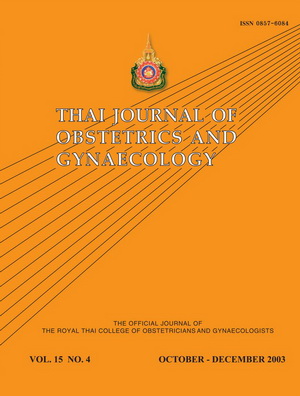Accuracy of Residual Urine Volume Measurement: Comparison Between Real-time Ultrasonography and Catheterization
Main Article Content
Abstract
Objective To determine the accuracy, percentage error and qualitative prediction of real-time ultrasonography using the new formula and the other 9 formulas from the literatures for the measurement of residual urine volume in gynecologic patients.
Design Descriptive study.
Setting Department of Obstetrics and Gynecology, King Chulalongkorn Memorial Hospital.
Subjects Patients who had vaginal surgery, radical or extended hysterectomy or other gynecologic patients whose residual urine volume had to be assessed in postoperative period.
Intervention Transverse, sagittal bladder diameters and area from transverse image were measured with real-time scanner immediately after voiding.
Main outcome measures Accuracy, percentage error of calculated residual urine volume using measured diameters and area for each of 10 formulas were compared to the corresponding measured total residual urine volumes. Sensitivity, specificity, accuracy, negative and positive predictive values when calculated residual urine volume greater than 100 mi. from each formula were analyzed.
Resuits Of 55 ultrasonographic measurements, 34 (62%) were associated with measured
total residual urine volume greater than 100 ml. For quantitative measurement, there was no correlation existed between the ultrasound calculated bladder volume and measured residual urine volumes for any of the 10 formulas. However for qualitative measurement of residual urine volume greater than 100 ml., the sensitivities and positive predictive values for each of 10 formulas varied between 70 and 100 percents, and between 68 and 100 percents, respectively.
Conclusions Catheterization remains the most accurate method of assessing postvoid residual urine volumes. Ultrasonography provides poor quantitative assessment of total residual urine volume but good qualitative assessment for residual urine greater than 100 ml. Therefore, ultrasonography might be useful where the risks of an accurate measurement outweigh the benefits of a less accurate assessment, as in elderly gynecologic patients. The new formula is easy to perform and calculate.


